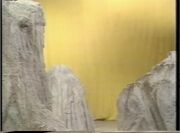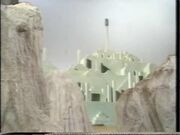CSO is the common acronym for a special effects procedure championed by producer Barry Letts during the Jon Pertwee era, but continued to be used by the program for a considerable time thereafter. It was created using an optical printer, although later methods, especially from the early '80s onwards, were done digitally, with a computer (the first one to be used for that process being the Quantel Paintbox, whose use in the programme began in the 1980 story The Leisure Hive). It allowed two different live shots to be mixed together to create the illusion of the two elements being in the same shot.
The acronym itself stands for colour separation overlay. Outside the BBC the process is generally known as chroma key.
Procedure

Shot from Death to the Daleks with yellow background.
As the name implies, it involves separating the colour of the background from one shot then overlaying that now-"background-less" shot onto another one. Usually the colour of the background will be green, blue or yellow, because these colours are not natural human skin tones. The mixer then "keys out" that colour, replacing it with the image of another shot.

Shot from Death to the Daleks with shot of Exxilon city replacing yellow.
While this "greenscreen" process is a common building block to other special effects processes, like CGI, what distinguishes CSO is the fact that the two shots are mixed together and then recorded live. Any errors of alignment, scale or colour separation are committed to the shot.
Loss of popularity
The procedure fell out of favour in dramatic presentations largely due to its inability to depict appropriate perspective between the two shots. The limitations of scale inherent in the process can clearly be seen in serials such as Invasion of the Dinosaurs and The Mutants. For this reason, CSO is now used mainly only in shots where scale is unimportant. A good example of such a usage is in the broadcasting of weather forecasts. A map will be placed in the same shot as a weather forecaster via CSO, largely because viewers aren't expecting that a weather broadcaster's hand will have the same scale as a map.
It has only been used in very incidental ways in the 2005 series of Doctor Who, such as when the "ghost forecast" was given in Army of Ghosts.
